
Healthcare distributor Cencora (NYSE:COR) reported Q4 CY2024 results beating Wall Street’s revenue expectations, with sales up 12.8% year on year to $81.49 billion. Its non-GAAP profit of $3.73 per share was 6% above analysts’ consensus estimates.
Is now the time to buy Cencora? Find out by accessing our full research report, it’s free.
Cencora (COR) Q4 CY2024 Highlights:
- Revenue: $81.49 billion vs analyst estimates of $77.46 billion (12.8% year-on-year growth, 5.2% beat)
- Adjusted EPS: $3.73 vs analyst estimates of $3.52 (6% beat)
- Adjusted EBITDA: $984.7 million vs analyst estimates of $1.03 billion (1.2% margin, 4.7% miss)
- Management raised its full-year Adjusted EPS guidance to $15.40 at the midpoint, a 3% increase
- Operating Margin: 0.9%, in line with the same quarter last year
- Free Cash Flow was -$2.82 billion, down from $810.9 million in the same quarter last year
- Market Capitalization: $48.77 billion
“Cencora delivered an excellent start to fiscal 2025 as we focused on advancing our core capabilities and enhancing our value proposition through differentiated services and solutions,” said Robert P. Mauch, President and Chief Executive Officer of Cencora.
Company Overview
The result of the 2001 merger between AmeriSource Health and Bergen Brunswig, Cencora (NYSE:COR) supplies pharmaceuticals and healthcare services to hospitals, pharmacies, clinics, and other facilities.
Health Insurance Providers
Upfront premiums collected by health insurers lead to reliable revenue, but profitability ultimately depends on accurate risk assessments and the ability to control medical costs. Health insurers are also highly sensitive to regulatory changes and economic conditions such as unemployment. Going forward, the industry faces tailwinds from an aging population, increasing demand for personalized healthcare services, and advancements in data analytics to improve cost management. However, continued regulatory scrutiny on pricing practices, the potential for government-led reforms such as expanded public healthcare options, and inflation in medical costs could add volatility to margins. One big debate among investors is the long-term impact of AI and whether it will help underwriting, fraud detection, and claims processing or whether it may wade into ethical grey areas like reinforcing biases and widening disparities in medical care.
Sales Growth
A company’s long-term performance is an indicator of its overall quality. While any business can experience short-term success, top-performing ones enjoy sustained growth for years. Luckily, Cencora’s sales grew at a decent 10.7% compounded annual growth rate over the last five years. Its growth was slightly above the average healthcare company and shows its offerings resonate with customers.
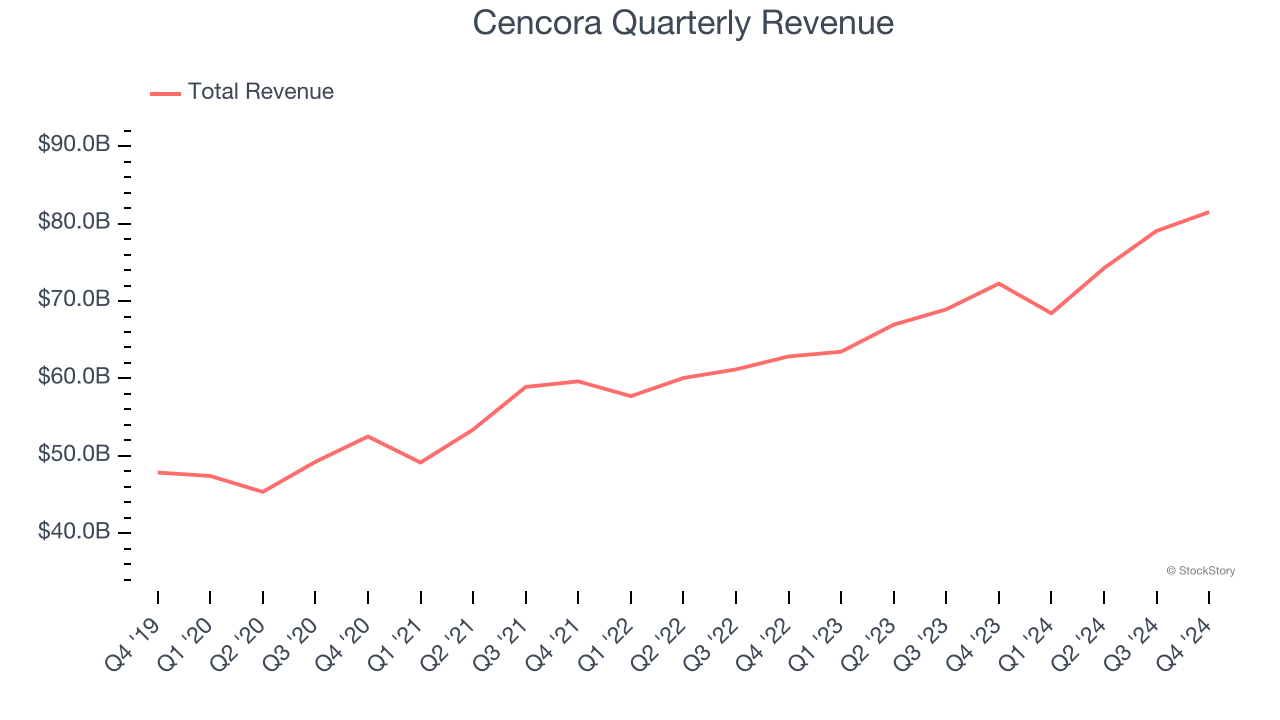
We at StockStory place the most emphasis on long-term growth, but within healthcare, a half-decade historical view may miss recent innovations or disruptive industry trends. Cencora’s annualized revenue growth of 12% over the last two years is above its five-year trend, suggesting some bright spots. 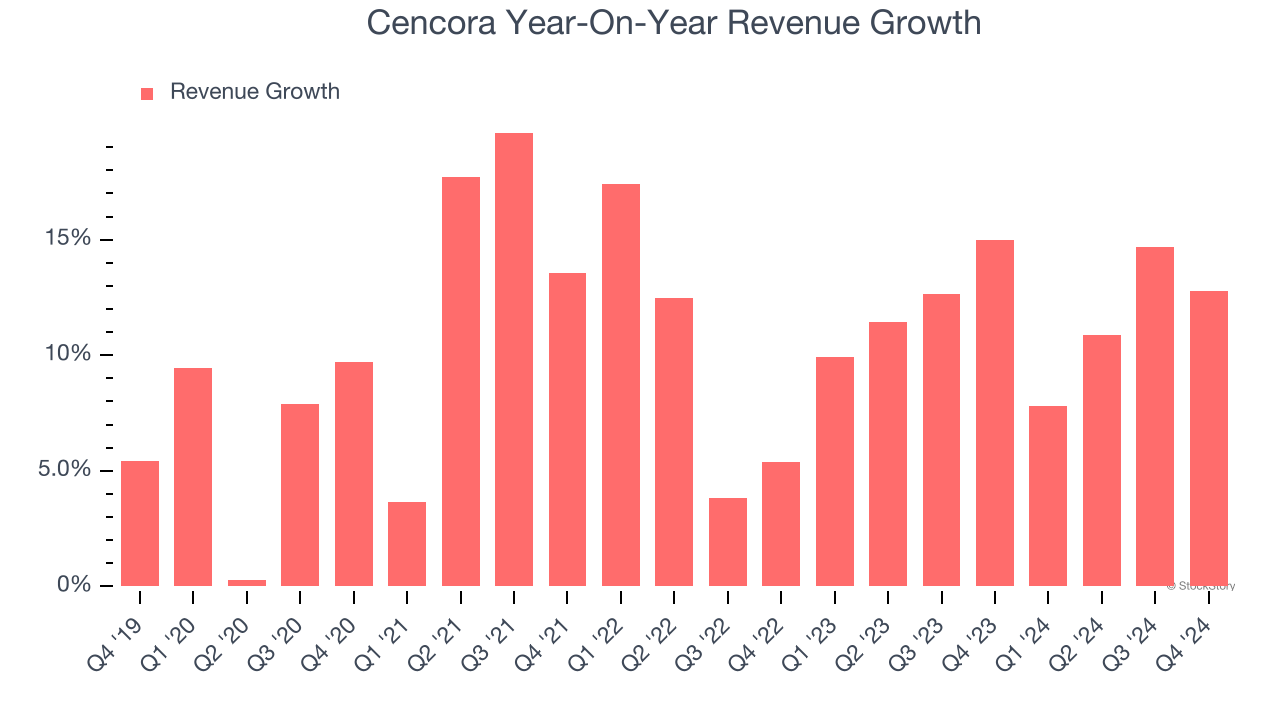
We can better understand the company’s revenue dynamics by analyzing its most important segment, US Healthcare. Over the last two years, Cencora’s US Healthcare revenue () averaged 12.8% year-on-year growth.
This quarter, Cencora reported year-on-year revenue growth of 12.8%, and its $81.49 billion of revenue exceeded Wall Street’s estimates by 5.2%.
Looking ahead, sell-side analysts expect revenue to grow 6.6% over the next 12 months, a deceleration versus the last two years. We still think its growth trajectory is satisfactory given its scale and suggests the market sees success for its products and services.
Unless you’ve been living under a rock, it should be obvious by now that generative AI is going to have a huge impact on how large corporations do business. While Nvidia and AMD are trading close to all-time highs, we prefer a lesser-known (but still profitable) stock benefiting from the rise of AI. Click here to access our free report one of our favorites growth stories.
Adjusted Operating Margin
Cencora was profitable over the last five years but held back by its large cost base. Its average adjusted operating margin of 1.3% was weak for a healthcare business.
Analyzing the trend in its profitability, Cencora’s adjusted operating margin might have seen some fluctuations but has generally stayed the same over the last five years, which doesn’t help its cause.
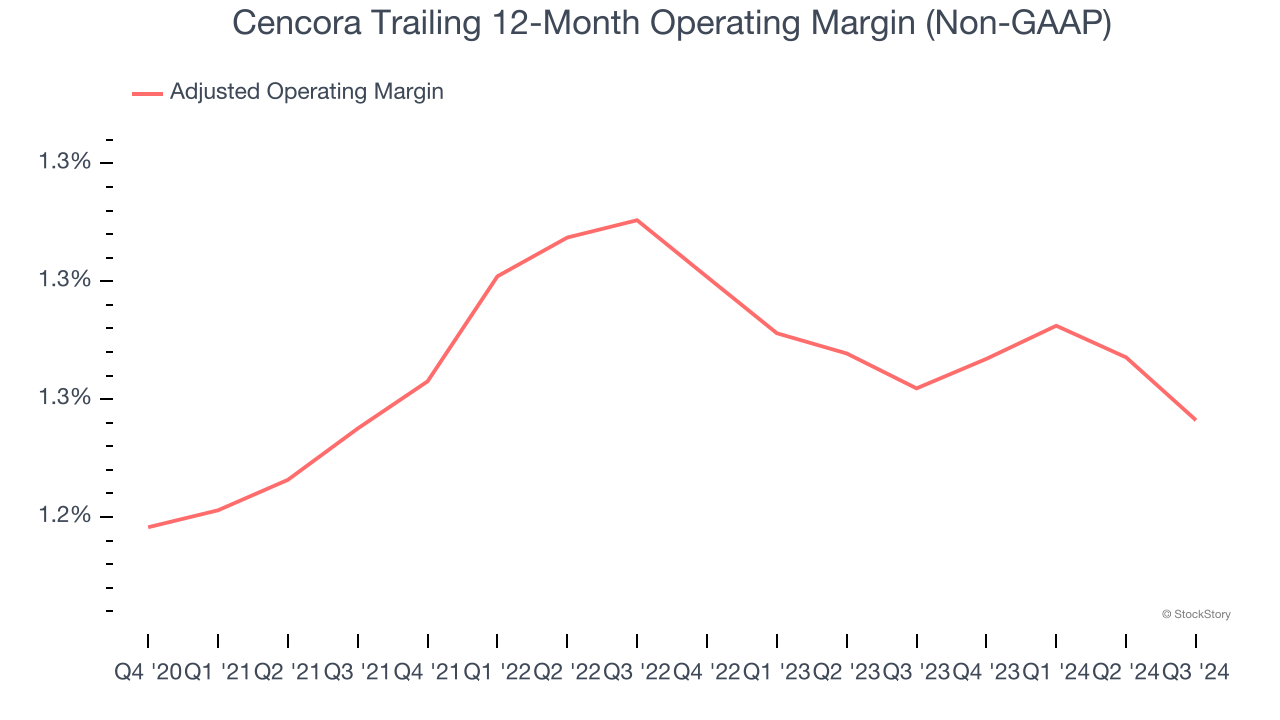
This quarter, Cencora generated an adjusted operating profit margin of 1.2%, in line with the same quarter last year. This indicates the company’s overall cost structure has been relatively stable.
Earnings Per Share
Revenue trends explain a company’s historical growth, but the long-term change in earnings per share (EPS) points to the profitability of that growth – for example, a company could inflate its sales through excessive spending on advertising and promotions.
Cencora’s EPS grew at a spectacular 14.4% compounded annual growth rate over the last five years, higher than its 10.7% annualized revenue growth. However, this alone doesn’t tell us much about its business quality because its adjusted operating margin didn’t expand.
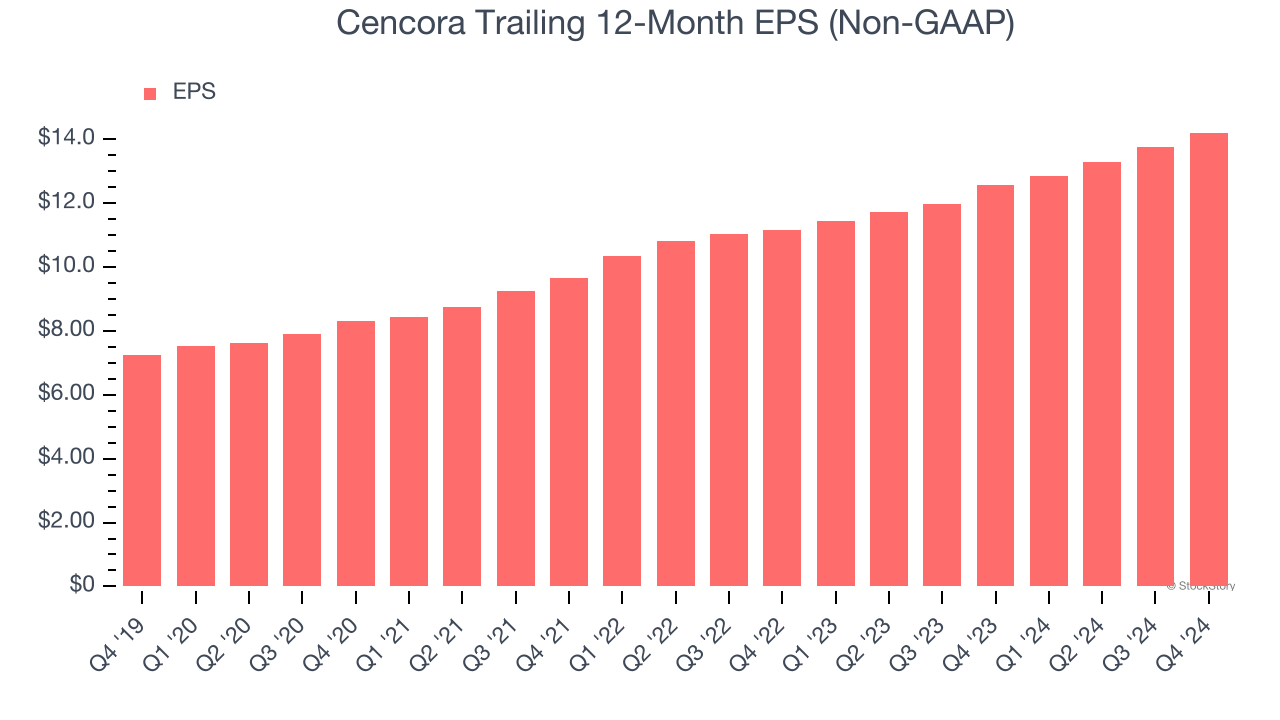
We can take a deeper look into Cencora’s earnings to better understand the drivers of its performance. A five-year view shows that Cencora has repurchased its stock, shrinking its share count by 5.9%. This tells us its EPS outperformed its revenue not because of increased operational efficiency but financial engineering, as buybacks boost per share earnings. 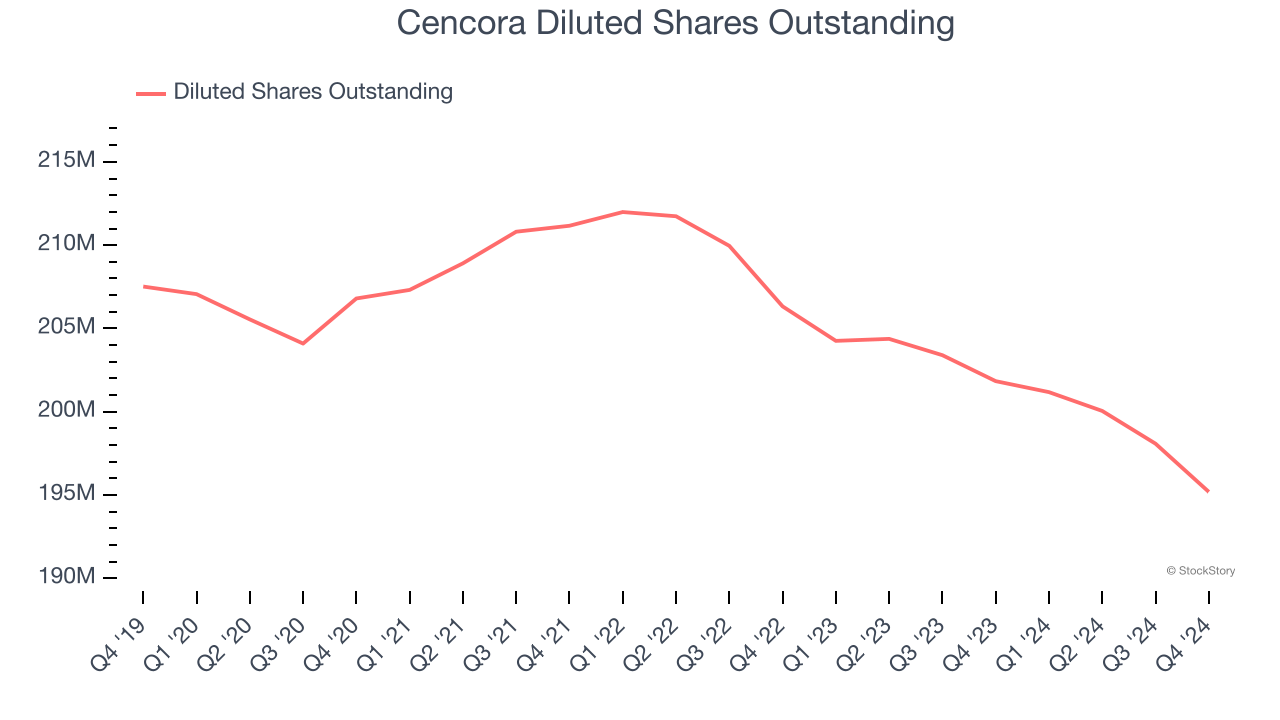
In Q4, Cencora reported EPS at $3.73, up from $3.28 in the same quarter last year. This print beat analysts’ estimates by 6%. Over the next 12 months, Wall Street expects Cencora’s full-year EPS of $14.21 to grow 9.8%.
Key Takeaways from Cencora’s Q4 Results
We liked that Cencora beat analysts’ revenue expectations this quarter. We were also happy its full-year EPS guidance narrowly outperformed Wall Street’s estimates. On the other hand, its EPS in the quarter was just in line. Overall, we think this was a solid quarter with some key areas of upside. The stock remained flat at $252.02 immediately following the results.
Sure, Cencora had a solid quarter, but if we look at the bigger picture, is this stock a buy? We think that the latest quarter is only one piece of the longer-term business quality puzzle. Quality, when combined with valuation, can help determine if the stock is a buy. We cover that in our actionable full research report which you can read here, it’s free.
